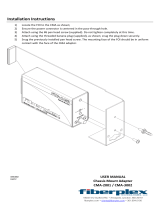
Getting Started
MODEL EST-66 Installation and Operation Manual Rev. 1.04A Page
3
2. Getting Started
2.1. Introduction to CMA Model EST -66
The EST is designed to give maximum cleaning in 44 inches. It represents the cleaning power
of machines twice its length. The curtains incorporated in the dishwasher minimize the transfer
of water from tank to tank during the wash and sanitizing procedures.
The energy costs for running the new EST-66 have been greatly reduced, by the introduction of
our new Stage Washing Process. The EST-66 Conveyor dishwasher (EST is abbreviation for
ENERGY STAR) lowers gallon/rack ratings and is directly related to CMA’s new Power-Rinse
Stage that has been introduced. The EST-66 new Re-circulating Wash and new Power-Rinse
Stage greatly reduce the amount of chemicals being used, thus adding a significant cost
reduction and energy efficiency to its’ operation.
The EST-66 can be used as a high or low temperature dishwasher, with the new wash tank and
power rinse tank designs, both having their own re-circulating pumps. The Power Rinse Stage
provides a fresh cleansing rinse, before the dish rack advances into the Power Rinse and Fresh
Water and Sanitizing Rinse Stages.
The initial-fill water and the final rinse water that is supplied to the EST-66 must be a minimum of
140°F, in low-temperature applications, while high-temperature machines will require two water
lines; one at a minimum water temperature of 140°F to fill the dishwasher, and the second with a
minimum of 180°F for the final rinse. With the introduction of the new optional E-Temp Booster
Heater, it will be offered fully integrated to the dishwasher.
The EST-66 also features a stainless steel scrap accumulator tank and tray, which must be
emptied on a periodic basis, as necessary. The EST machine is designed to deliver 0.49 gallons
of fresh rinse water for each rack. This water flows from the rinse and power-rinse tanks into the
wash tank, and then overflows into the scrap tray, carrying any debris that may have fallen into
the wash tank, thereby providing a much cleaner environment for the washed and rinsed dishes.
If preferred, there are also options such as a Corner Feed System, optional Vent Hood Adapters,
Exhaust Fan Control Circuits and a Drain Tempering Kit. CMA also offers a full line of other
machine accessories, including stainless steel dishtables. (See equipment catalog)
DISCLAIMERS
CMA expressly disclaims any and all warranties, express or implied, relating to the installation of any and all CMA equipment that
is installed by chemical dealers, contracted servicers or third party servicers to CMA equipment. If the installation instructions
are not followed exactly (to the letter), or, if any person or company conducting the installation of the CMA equipment, revise the
installation procedures or alter the instructions in any manner, the CMA warranty becomes void. If, due to the improper
installation of CMA equipment, this equipment ceases to operate properly or affects other parts of the CMA dishwashing
equipment, in that the other parts become defective, the CMA warranty becomes void. CMA will not be liable or responsible or
warrant CMA equipment, due to improper installation of any CMA model dishwasher.
CMA does NOT endorse “Tankless On-Demand” water heaters for use on CMA Dishmachine products. On most applications, the
volume of hot water required for commercial dishmachines exceeds the capacity of these types of heating sources. You will find
that most, if not all, commercial dishmachines have been programmed with auto-filling features that require quick filling, with a
designated limited time.
CMA DOES endorse, and highly recommends, the standard “tank” style water heaters, sized properly to handle each particular
facility with their water heating requirements. A “tank” style water heater stores and supplies a large capacity of preheated water
before providing hot water to the dishmachine. To meet required health codes, there must be a reliable and consistent flow of
adequate hot water supplied to the dishmachine. If the facilities’ “tank” style water heater is marginal in size, CMA recommends
installing a proper size Hatco Booster Heater, a CMA’s E-Temp 40 or 70-degree-rise Booster Heater (that can be installed on CMA
Conveyors), or a CMA Temp-Sure Booster Heater (for door and undercounter dishmachines). All are designed to adequately
achieve results.
Important: Make sure incoming power supply corresponds to the voltage listed on the data plate. If the voltage is too low (206V or
less), the heating elements will not reach desired temperature specified by manufacturer, and performance will be compromised.
The heating element needs to be sized according to the facilities available voltage, which must be noted on your purchase order
to CMA for a special dishmachine. Special lower voltage higher kilowatt heaters are available upon request.
Make sure a fused disconnect switch or circuit breaker (not supplied) is installed in the electrical service lines supplying this
dishwasher and should meet the requirements of your local electrical code.
Warning: cancer and reproductive harm – www.P65Warnings.ca.gov























